|
|||||||
| Sponsored Links (Register now to hide all advertisements) |
|
|
 |

|
Thread Tools | Display Modes |
|
|
#1 |
|
Senior Member
Join Date: May 2010
Location: South Texas
Posts: 1,631
|
I keep seeing posts about identifying a flathead motor. I have been waiting for someone to do a nice post, or thread, with pictures identifying each style of flathead V8 block. In the absence of that, I'll do the next best thing; I volunteer to put the list together. I can provide pictures of an 8BA block, a 39 Mercury block, and probably a 36 LB block. I need pictures of the other blocks. If anyone has a bare block, or pictures of a bare block, could you post, or message me with the pictures?
A list of the production line blocks, this list does not include replacement blocks: 1932 - straight down drain cocks, no recessed area at front of motor 1933 - early had angled drain cocks, no recessed area at front of motor late had angled drain cocks, start of recessed area 1934 - same as late 33 1935 - start of crankcase ventilation, late castings have insert mains 1936 - insert mains 1937 - relocated water pumps 1938 - early, same as 37 late, 24 stud heads 1939 - Ford similar to 38 with larger mains Mercury larger bore 1940 - same as 39 both Ford and Mercury 1941 - No freeze plugs in oil pan rail, intake area now looks raised 1942 - same as 41 both Ford and Mercury WW2 - no one really knows 1946 - the 59 series engines, valve angle changed, fails pencil test, etc 1947 - same as 46 1948 - cars same as 46-47. new pickups get 8BA 1949 - 8BA: removable bell housing, changed water passages 1950 - 8BA sometime around here the intake valve seats were eliminated 1951 - 8BA 1952 - 8BA sometime around here the exhuast valve seats were eliminated 1953 - 8BA 1954 - Austrialians and others used 8BA for last year, no USA flatheads What I would like for pictures is: a front picture, a top picture, and a rear picture. If this goes well, I would like to do the same with heads, intakes, carburetors, distributors, etc. Thanks! Last edited by 38 coupe; 01-12-2011 at 07:28 PM. |
|
|

|
|
|
#2 |
|
Senior Member
Join Date: May 2010
Location: Colorado
Posts: 553
|
This is a great idea. I can't help with it, but could sure use this kind of information.
Thanks for the help. Royal Ryser |
|
|

|
| Sponsored Links (Register now to hide all advertisements) |
|
|
|
|
#3 |
|
Senior Member
Join Date: May 2010
Location: Lee's Summit, Mo
Posts: 338
|
I have bare blocks that have been hot tanked for 1941 Mercury and 1946 Ford 59. Do you want the pictures sent to you?
|
|
|

|
|
|
#4 |
|
Senior Member
Join Date: May 2010
Location: South Texas
Posts: 1,631
|
I have been digging around the web and have some pictures of the following blocks so far:
1935 - very rusty, but decent detail 1937 - very rusty, but decent detail 1939 - some pictures taken from a thread here 1941 Mercury - rusty but decent detail. Hopefully more pictures from 26 lakes hot tanked block 1946 59L block - rusty but decent detail. Hopefully more pictures from 26 lakes hot tanked block 1949 8BA - top view only Maybe this Friday I can get pictures of my 39 Mercury blocks, my dad's 36 LB block, and dad's 41 Ford block. If anyone can help with more pictures, I'd really appreciate it. |
|
|

|
|
|
#5 |
|
Senior Member
Join Date: May 2010
Location: Arizona, USA
Posts: 288
|
I use this website normally for my flathead ID questions. Mr. VanPelt has done a very nice job with it all around. It never hurts in my humble opinion to have other sites to cross check with too. I am looking forward to seeing your site when you are done with it too.
http://www.vanpeltsales.com/ |
|
|

|
|
|
#6 |
|
Senior Member
Join Date: May 2010
Location: Arizona, USA
Posts: 288
|
Sponsored Links (Register now to hide all advertisements)
 Just what does it take to be a "senior member"? I was posting a lot on this site long before it changed hands a while back. |
|
|

|
|
|
#7 |
|
Senior Member
Join Date: May 2010
Location: Waddell, AZ
Posts: 2,540
|
thirt4....ya gotta keep posting...after a certain number....100??....you become senior...old posts on the old 'Barn don't count...lol....Mike
|
|
|

|
|
|
#8 |
|
Senior Member
Join Date: May 2010
Location: Arizona, USA
Posts: 288
|
Mike in Az - Did you sell me a windshield frame earlier this year?
|
|
|

|
|
|
#9 |
|
Senior Member
Join Date: May 2010
Location: Cincinnati, OH
Posts: 1,361
|
I like this idea! Someone did this some years ago....I think for an article in the EFV8 Club mag. Pics were a little grainy. If i could make a suggestion....if possible add a pic the the particular block from the bottom. Some had the freeze plugs in the oil pan rail and some did not. Also, those bottom pics would be great if they had the main caps in place....some had studs and some had bolts.
If you want a place to park the pics for future reference, I would be happy to include them on our site's Engine Identification pages.
__________________
VANPELT SALES LLC Cincinnati, Ohio Office: 513-724-9486 www.vanpeltsales.com www.classictransmission.com |
|
|

|
|
|
#10 |
|
Senior Member
Join Date: May 2010
Location: Near Rising Sun, Maryland
Posts: 10,858
|
Mac that would be great. Your website is awesome now and adding ID pics of all the different FH blocks would make it even "awesomer" (or should I say "more awesome"). I like making up new words

__________________
John "Never give up on what you really want to do. The person with big dreams is more powerful than one with all the facts". Albert Einstein |
|
|

|
|
|
#11 |
|
Senior Member
Join Date: May 2010
Location: South Texas
Posts: 1,631
|
I have several pictures collected, mostly from this forum. I'll post an updated list of what I have collected on Monday evening. If anyone else would like to provide pictures to me, give me a private message and I'll give you my e-mail.
|
|
|

|
|
|
#12 |
|
Senior Member
Join Date: May 2010
Location: South Texas
Posts: 1,631
|
I pictures of the following:
32 assembled engine, oil pan, and drain petcock 33 assembled engine 35-36 bare block and assembled engine 36 LB bare block 37-early 38 bare block 38 24 stud assembled engine *shameless plug - I would love to have a NOS set of 1938 81A heads* 39-40 Ford bare block 39-40 Mercury bare block 41-42 Mercury bare block 46-48 59 series bare block 49-53 bare block A tin can sleeve Should I post these on this thread or make a new thread for them? |
|
|

|
|
|
#13 | |
|
Senior Member
Join Date: May 2010
Location: Waterford, CT
Posts: 250
|
Quote:
__________________
Joe/Ct  "The older I get, the better I was" "The older I get, the better I was" 
|
|
|
|

|
|
|
#14 |
|
Senior Member
Join Date: May 2010
Location: South Texas
Posts: 1,631
|
Here we go. If all goes well I should end up with thumbnail pictures that you then click to have the full size picture come up. Most of the pictures have been collected on the Ford Barn.
Here is the 221-239-255 cube flathead block story with pictures, to the best of my knowledge and ability to collect pictures so far. In the beginning of this story it is 1931 and Chevrolet has a 6 cylinder car. Henry Ford had to upstage them. Henry had a crash program going to develop an 8 cylinder motor, but it was not developed enough to put in production. Henry gave the order to start production of the improved 4 cylinder car for 1932, the model B. Apparently as Henry walked past the newly started production line turning out the shiny new 1932 4 cylinder Fords he made the decision to shut the line down and introduce the V8! Ford dealers were without cars for months. Ford Motor Company knew the first V8s were so bad that the first 1500 were not allowed to be sold to the public, they were for static display only and were supposed to be returned to Ford for engine swaps before being sold. And so, into the turbulent under developed world of prototype motors, the V8 Ford was introduced. The number of production changes to engine design in 1932 was phenomenal. A proper discussion of 1932 Ford V8 motors would include as many pictures, or more, as I have in this history discussion. Maybe Dave Cole or David Rehor know all of the changes made in 1932, but I sure don't. And so, if you visit the Henry Ford Museum you can see production V8 number 1, 18-1 itself. This engine was actually prototype motor number 243, but they had to start somewhere. The very early 32 motors feature some unique features, such as bolt on steady rod brackets and a block mounted dip stick. These features can be seen in this picture of 18-1: 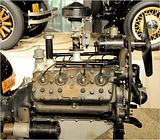 Early in production the oil dip stick was relocated to the oil pan and the block castings were changed to locate the steady rods in the bell housing casting. The 1932 V8 engines features a 3 1/16 bore by a 3 ¾ stroke for 221 cubic inches. The main bearings were 1.998 to 1.999 inches and the rod bearings were 1.998 to 1.999 inches. There was no provision for crankcase ventilation. The oil pan rail had four freeze plugs, two per side. The block featured drain petcocks pointed straight down at the front. The vertical drain petcocks and a bulge in the pan rail for a freeze plug can be seen in the following picture: 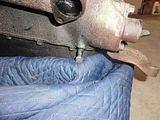 The front motor mounts bolted to brackets on either side of the timing cover. Interestingly these bolt holes were still drilled and tapped on all other American built flatheads. They continued to be used through 1936 for motor mounts, then they were not used again until 1953 trucks! The front of the block in 1932 was flat between the water inlets and the timing cover. The crankshaft were forged in 1932, the only 221-239-255 cranks to be forged, and they featured a very short snout. The snout was just long enough to hold the timing gear, crank pulley, and its retaining nut. This short crank snout was continued to the end of 1938 engine production. The 1932 motor mounts, flat block, and short crank can be seen in this picture: 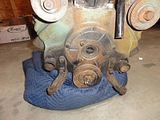 1932 V8 engines did not use cam bearings. Camshafts ran right in the cast iron. I do not know if there is enough material in the block to cut for conventional cam bearings. 1932 was also the only year Ford used a forged camshaft in the flathead V8s. Racers used to search for these camshafts to regrind for racing camshafts. I have not covered the rest of the 1932 one-year-only engine parts as this comprises almost the whole engine. If I ever get around to doing similar discussions on intakes, water pumps, distributors, etc, I will try to cover each in their respective story. By the beginning of 1933 production, Ford had developed the V8 engine to the point that it was no longer a prototype motor being tested by the public. 1933 also continued the quest for more performance. The heads were changed to aluminum for passenger car use and the compression ratio was raised. The advance curve in the distributor was changed on the passenger car engines with aluminum heads to allow 22 total degrees instead of 18, 4 crankshaft degrees more advance. The advance curve change was a one year deal as Ford reverted back to 18 total in 1934 and stayed with 18 degrees total through the end of the front mount distributors. The front motor mounts were relocated to the water inlets, and the oil pan was made out of stamped steel. The front of the block between the water inlets and the timing cover had a recess added early in the 1933 production run to save some iron. This recess is featured on all flathead V8s from 1933 on. Crankshafts were now cast rather than forged, though some of the forged cranks continued to find their way into engines through 1934. The blocks still did not use cam bearings. The water petcocks are angled out instead of straight down. Some early Canadian blocks had casting to allow the block to be machined for either straight down or angled petcocks. The pictures of 1933 blocks are provided by David J. These are 3 1/16 bore, 21 stud blocks. The recesses between the water inlets can be seen on the front of the block in this picture. The recesses in the 1933 blocks are the same depth on both sides of the timing cover. This engine has a forged crankshaft. The engine was upside down when this picture was taken and I flipped the picture over. 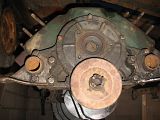 This is the crankcase area of a 1933 block. Note the four freeze plugs in the oil pan rail and the area to the passenger side of the front main bearing as it lacks the opening for crankcase ventilation. The distance between the studs on the main caps will measure approximately 3 inches center to center, common to all poured bearing Ford V8 blocks. 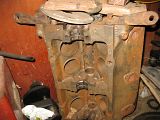 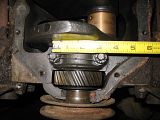 Here is the oil pump, rear main, and flywheel of the 1933 motor with the forged crankshaft.  The fuel pump push rod area of the non-ventilated blocks looks like this.  David J also provided pictures of both a forged crankshaft and a cast crankshaft. The forged crankshaft has a constant width #2 counterweight while the cast crankshaft has an extra bit of weight cast in that makes the counterweight thicker on the outer part, among other differences. The differences can be seen in these pictures. The forged crankshaft is on the left and cast crankshaft is on the right. 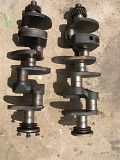 Here is a closer look at the rear of the crankshafts. Again, the forged is on the left. 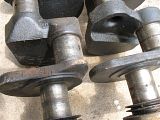 1934 featured an exciting upgrade for the Ford V8, the world's first 180 intake manifold. As far as the engine block is concerned, 1934 was the same as 1933. 1935 engines finally got crankcase ventilation. This was added as a triangular vent in the front of the block, next to the front main bearing. With the addition of the vent in the passenger side of the block, the recess between the timing cover and the water inlet on that side of the block was made shallower. The oil pan was modified to work with this vent area and has a funny little triangular protrusion with a slot in the back. 1935 blocks also started using cam bearings. These are 3 1/16 bore, 21 stud blocks. Here is the crankcase area. Notice the crankcase ventilation hole next to the front main bearing. 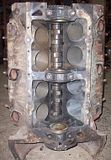 Here is the front of the block. Notice the depressions between the water inlets on each side of the timing cover. It is hard to see in this picture, but the passenger side depression is shallower than the driver side depression.  Another change to come with the crankcase ventilation was a cast in baffle in the fuel pump push rod area of the valley, as can be seen in this picture. 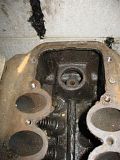 The noteworthy feature in this picture is the crankcase breather tube. 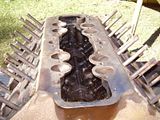 Late in 1935 Ford introduced V8 engines with insert main bearings. This is the block that is known as the 36 LB. Ford kept producing poured bearing blocks along side the insert bearing blocks during 1936 production. There is sometime an LB stamped on the passenger side intake rail near the front of the block, indicating an insert bearing motor. I have seen insert bearing motors without this marking. I also suspect that at least one motor has had someone add this in a dis-honest attempt to get more money for a motor. The main bearings were enlarged to 2.400 inches on the insert bearing blocks and the main cap studs were moved apart to make room for the bigger bearings. The distance between the main cap studs on an insert block is approximately 3 ¼ inches. The oil pan was modified to fit over the larger main caps. These are 3 1/16 bore, 21 stud blocks. Here is the front of an insert motor. Notice how the exterior features are identical to the poured motor.  I have been told that Canadian blocks of this era feature this hole. 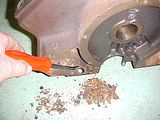 1937 and later Ford V8 engines were all insert main motors. The water pumps were moved from the heads to the front of the block. This was done to improve cooling. The water outlet was moved to the center of each head. Early 1937 passenger car engines had aluminum heads, while most production used cast iron heads. Ford make block off plates to cover the water pump mounts on these blocks to allow 1932 through 1936 heads to be used on these motors. These are 3 1/16 bore 21 stud blocks. Here is the water pump mounting area on the front of the block. 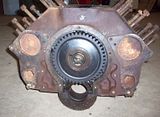 The crankcase area was mostly unchanged from the earlier insert bearing motors. The main bearing size remained 2.400 inches. 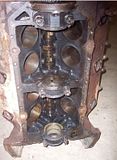 The cylinder head deck is pretty much identical to the earlier 21 stud blocks.  In 1938 is when the story starts to get confusing again. Early 1938 Fords continued with the 21 stud motor from 1937. At the same time Ford started casting blocks with 24 studs per cylinder head, and these motors started filtering into production. The later in the production run a 1938 Ford is, the more likely it is to have a 24 stud motor. The crankshaft, main bearings, accessories, in fact everything else but the block and heads, was the same between 21 and 24 stud motors in 1938. Why then did Ford bother? The answer comes in 1939. These are 221 cubic inch engines, either 21 or 24 stud. Here is a picture of a 1938 24 stud motor. The cylinder heads are one year only, featuring a cast in part number on the face of the heads. The battery cable is not supposed to attach to the middle head stud. 
Last edited by 38 coupe; 06-21-2011 at 06:40 PM. Reason: Add more information and pictures |
|
|

|
|
|
#15 |
|
Senior Member
Join Date: May 2010
Location: South Texas
Posts: 1,631
|
There is a 20 picture limit per post, so I am continuing the story in a new post.
1939 saw several changes to V8 engines. The biggest changes were due to the introduction of the Mercury. The Mercury had an engine based on the Ford V8, but with a noticeable increase in torque and a nice bump in horsepower. The additional power came as the result of additional displacement, 239 cubic inches instead of Ford's 221 cubic inches. The additional cubic inches came from a 1/8 inch larger bore, to 3 3/16 inches. Now we have the reason for 24 studs per head. The lower line of studs on the 21 stud motors is too close to the bore for safe production of 239 cubic inch motors. With the addition of more power came larger main and rod bearings, this time 2.500 inch diameter mains and 2.140 inch diameter rods. The Ford blocks got the bigger mains too, but continued with the smaller 2.000 inch rod bearings. Another difference started with 1939 motors is a longer crankshaft. Ford and Mercury mounted the engine fan on the end of the crankshaft in 1939, 1940, and 1941. To allow the fan to be held onto the snout of the crankshaft, the snout was made longer. Starting in 1939 some V8 blocks were relieved between the valves and the bore at the factory. This was done to reduce compression and detonation problems on large trucks. Both 3 1/16 bore and 3 3/16 bore blocks may be factory relieved. All blocks still have four freeze plugs in the oil pan rails. The deck and front of the block on the 221 cubic inch Ford motor is almost identical to the 1937-1938 21 stud motor, with the exception of 24 head studs. The water holes in the deck and other similarities can be seen the following two pictures. These blocks can be bored 1/8 over to 239 cubic inch size so a 3.1875 bore should not be used to determine block identity.  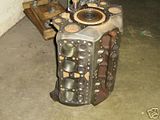 The 239 cubic inch Mercury engine was also optional in trucks. The water holes in the deck feature a circular center instead of the upside down keystone. Some 239 blocks had 99 stamped into the passenger side intake rail near the front, but not all. As with the LB, an unscrupulous person could have added this marking to a less desirable engine also. The determination on one of these blocks should be made using the center water holes in the deck. Mercury motors will have an upside down keystone at the bottom and a circular hole in the middle. These can be seen in the following picture. This is a factory relieved new old stock block owned by a Ford Barn member. 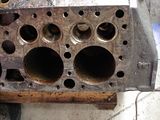 1940 engine blocks are identical to 1939 blocks as far as 221 and 239 motors are concerned. Interesting things were happening to the 60 horsepower motors, but that is a different story. 1941 feature some detail changes compared to all the previous 221 and 239 cubic inch V8 motors. The freeze plugs in the oil pan were eliminated and the intake deck is no longer flat. This is referred to as a raised intake block, but actually the intake is the same height and the surrounding area is sunken a bit. This was probably done to save a bit of cast iron and prolong cutting tool life. Another interesting feature of the 1941 motors is the outside wall of the block that the exhaust ports exit through. 1932 through 1940 blocks are flat with raised exhaust ports. 1941 blocks are curved between the exhaust ports. The 221 and 239 cubic inch blocks can still be differentiated by the center water holes in the cylinder head decks. The curve in the outer block wall and the raised intake can be seen in this picture. Compare the block side in this picture to the block sides in the lower 1939 Ford block picture. 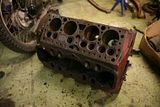 The flat oil pan rail without the bulges for freeze plugs can be seen in this picture.  1942 blocks were the same, Ford and Mercury, to 1941 blocks. All prewar, 1932 through 1942, V8 blocks will pass what is known as the pencil test. The front of the block above the timing cover has a little shelf that makes the top of the timing cover face in the block. If you can rest a pencil on the block at this location, you have a prewar block. Make sure you are not resting the pencil on the timing cover itself. Here is a picture of a 1938 motor passing the pencil test. 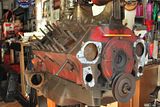 Also, be wary of Ford literature on engine identification. Ford did not care about correct year blocks, Ford cared about whether the engine would bolt into and be usable in a particular car. A good example of this can be found on this identification page. The 1932, and 1933-1934 blocks are all wrong in this example. The features specific to performing maintenance on any particular year car or truck are correct. 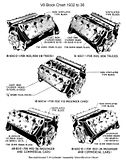 World War 2 – I have no idea what all the flatheads during the war years looked like. I have seen pictures of military engines with features similar to the French flatheads and I have seen a picture of a G series six cylinder with a front mounted post distributor. It is an interesting subject, but not one I can add much to. 1946 Ford and Mercury engines are identical. This is the start of the 59 series motors. All engines feature 3 3/16 bore by 3 ¾ stroke for 239 cubic inches. The blocks have a 59 cast on the top of the bell housing, if someone hasn't ground it off. The front of the block now slopes from the intake rail down to the timing cover so the pencil test fails. The intake rail is back to flat. The water holes in the bottom center and middle center of the cylinder head deck are round. The cast in bell housing still has holes for the engine steady rods. Main bearings are 2.500 inches and rod bearings are 2.140 inches. Sometime during the war, Ford changed the angle between the valves. Pre-war blocks have 101.5 degrees between the valve centerlines and postwar blocks have 100 degrees between valve centerlines. This means the valves are about 0.090 inches further away from the bore on postwar blocks. This was done to reduce cracking between the valve ports and the bore. This also affects the cam timing a bit, so be careful that the cam you use is for the series motor you are using it in. Here is an example of a 59 cast on the bell housing. This particular block has an L, there are many other letters that can be found here, or no letter at all. There has been a lot of conjecture about certain blocks being either Canadian or Military and having either thicker walls or more nickel in the castings. I am not aware of any metallurgical testing of blocks, so for practical purposes, all 59 series blocks in good condition are equivalent.  The intake rail is clearly flat again as can be seen in this picture. Someone has relieved this block around the valves following a head gasket as a guide. 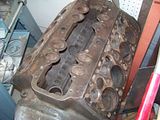 The circular water holes in the center of the cylinder head deck can clearly be seen in this picture.  1947 Ford and Mercury engines are identical to 1946. 1948 Ford and Mercury engines are identical to 1946 with the exception that the new 1948 pickups had the new 8BA style engine. 1949 Ford and Mercury blocks are identical with 3 3/16 inch diameter bore. There is no cast on bell housing. These motors featured revised cooling passages, most notably at the top of the water pumps and at the rear of the cylinder head deck. Engine oil passages are revised slightly to eliminate the pressure relief valve at the front of the valley. The crankcase ventilation system is revised, with the crankcase breather and road draft tube coming off the intake manifold. Main and connecting rods continue with the same diameter as before, but the connecting rod bearings are not floating and are individual per rod. The crankshafts now have two oil holes per crank throw instead of one. Distributors are now post style in front of the passenger side head. The fan belts an pulleys are moved forward to make room for the new distributor (this can cause problems when trying to put an 8BA into a 1932, 1933, or 1934 Ford). Ford engine continue with 239 cubic inches, but Mercury goes to a 4 inch stroke to get 255 cubic inches. The revised cooling passage at the rear of the cylinder head deck can be seen in this picture. 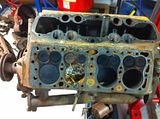 The added cooling passage at the top of the water pump can be seen in this picture. 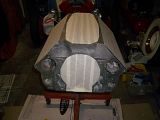 The back of the block with no cast on bell housing can be seen in this pictures. This block has been modified for a full flow oil filter.  1950 Ford and Mercury passenger cars switch from wide belts to narrow belts. The blocks are identical to 1949. 1951 Ford and Mercury started using rotating exhaust valves during this year. Also, the hardened intake valve seats were eliminated and the intake seats were cut directly into the block sometime around 1951 production. 1952 Blocks are the same as 1949 blocks with the exception of not having hardened intake valve seats from the factory. Somewhere in this time frame the hardened exhaust valve seats were phased out too. 1953 Blocks are the same as 1949 blocks with the exception of not having hardened intake valve seats and possibly not having hardened exhaust valve seats from the factory. 1954 Canadian and Canadian sourced cars still have the flathead. Blocks are the same as 1949. Last edited by 38 coupe; 03-10-2014 at 08:57 PM. Reason: add picture of pencil test |
|
|

|
|
|
#16 |
|
Senior Member
Join Date: May 2010
Location: southeastern Michigan
Posts: 10,101
|
Those aren't freeze plugs in the bottom of a '32 (and other) blocks. With the oil pan in place, they become immobile. The list of all the many changes to the '32 V-8 block and nearly every other engine component consumes a fair chunk of the new '32 book. For those interested in that level of detail, the book is a bargain.
Dave |
|
|

|
|
|
#17 |
|
Senior Member
Join Date: May 2010
Location: South Texas
Posts: 1,631
|
What is the proper name for those plugs? Most of my reference literature is actually my dad's reference literature and lives at my folk's house. I did not find a part number and description for the plugs in the Green Book, the only parts book I have at my house, so I referred to them by the name I have heard them called.
DavidG is right, that book is a bargain for what you get. Last edited by 38 coupe; 05-31-2011 at 06:37 PM. Reason: Plug for the 32 book. |
|
|

|
|
|
#18 |
|
Senior Member
Join Date: May 2010
Location: At my kitchen table in Santa Rosa, Ca
Posts: 2,903
|
welch plugs?
__________________
If it would have been a snake it would have bit ya! i can't spell my way out of a paper bag! |
|
|

|
|
|
#19 | |
|
Senior Member
Join Date: Jun 2010
Location: St Croix Falls WI
Posts: 2,080
|
74113-S is called " plug{ water jacket } " . 32-34 4 required . Info from a 3/5/34 parts book . 38 coupe if you need any pics of 33-34 motor stuff let me know as I have a few . Quite a few changes to motor related stuff 33-34 but not as many as 32 . David J
Quote:
|
|
|
|

|
|
|
#20 |
|
Senior Member
Join Date: May 2010
Location: South Texas
Posts: 1,631
|
I'd love to have some good 32-33-34 engine pictures. What you see in the post above is what I currently have. I'll send you a private message with my email address so you can send them to me.
Also, is the information accurate? I wrote most of that from my memory of old V8 Times articles like Model 18 Notes. Thanks! Last edited by 38 coupe; 06-01-2011 at 06:41 PM. |
|
|

|
|
|
#21 |
|
Senior Member
Join Date: Oct 2010
Location: North Pole, Alaska
Posts: 1,470
|
What is the extra oil line at the rear of the 8BA block with the full flow system for?
|
|
|

|
|
|
#22 |
|
Senior Member
Join Date: Aug 2010
Location: Blenheim, New Zealand
Posts: 879
 |
It is my understanding that, in Canada, they made a transitional block between the 59 and 8BA, that being the C69A and these blocks were produced with an 8BA crank and rods from the factory.
I have one buried in my garage somewhere and will dig it out some time soon and photograph it for reference purposes and at the same time I will check it for sleeves too.
__________________
I need an 01A 1453 Brkt Spare wheel hold down for my sedan delivery - PLEASE HELP  Gotta love my '42 Sedan Delivery's - Now that I own the only two in New Zealand  http://www.fordbarn.com/forum/album.php?albumid=580 |
|
|

|
| Sponsored Links (Register now to hide all advertisements) |
|
|
|
|
#23 |
|
Senior Member
Join Date: May 2010
Location: London On, Can.
Posts: 377
|
Wonderful engine infor.couple of points 39 US engins used tin can sleeves Canada never used them .re the hardness can, engins were much toughter one can tell the difference with a file. and they never needed the tin cans .Can. engins had 3 oil outlets on the bell housings .They started to use insert bearings ahead of US..46 Can cars could be ordered with either the 3 3/16 or 31/16 size to 48. John Canada.
|
|
|

|
|
|
#24 |
|
Senior Member
Join Date: May 2010
Location: South Texas
Posts: 1,631
|
I added 1933 engine and crankshaft pictures that David J provided.
Many thanks to the people who helped with this. Picture of a tin can sleeve as mentioned by our Canadian compatriot. 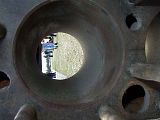
Last edited by 38 coupe; 06-08-2011 at 09:55 PM. |
|
|

|
|
|
#25 |
|
Senior Member
Join Date: Jun 2010
Location: St Croix Falls WI
Posts: 2,080
|
Something to consider : Look at the cast in vent tower around the fuel pump bushing on the 35-36 block . Look at the holes drilled for the main cap bolts on the 33 block by the fuel pump bushing . Same issue with the RF main cap bolt -v-vented block . This kinda ends the bolt-stud mystery with me . Mebbe y'all nowd dis aready but me dint . An dasssa gooot
 David J David J
|
|
|

|
|
|
#26 |
|
Senior Member
Join Date: May 2010
Location: Alameda, California
Posts: 335
|
Sponsored Links (Register now to hide all advertisements)
|
|
|

|
|
|
#27 |
|
Senior Member
Join Date: May 2010
Location: Sweden
Posts: 427
|
Maybe this could be of some help.
|
|
|

|
|
|
#28 |
|
Senior Member
Join Date: May 2010
Location: South Texas
Posts: 1,631
|
That is the article that got me started on flathead block identification. It is a nice article, but leaves a lot out. Thanks for posting it.
Matt in Alameda - the paragraph right under the line about 1942 blocks gives a description of the pencil test. I need to get out to my Dad's shop and take a picture of one of our prewar blocks with a pencil on it. |
|
|

|
|
|
#29 | |
|
Senior Member
Join Date: May 2010
Location: Everett, WA
Posts: 504
|
Quote:
 http://smg.photobucket.com/albums/v5...9498BAback.jpg This looks like the Red's Header's version that supplies filtered oil to the rear main that is normally not filtered by the so called 95% full flow mod. |
|
|
|

|
|
|
#30 |
|
Senior Member
Join Date: Jun 2010
Location: St Croix Falls WI
Posts: 2,080
|
Rowdy had questions about ID'ing a 21 stud block and this should do it .
|
|
|

|
|
|
#31 |
|
Senior Member
Join Date: May 2010
Location: Near Rising Sun, Maryland
Posts: 10,858
|
I just went back and looked at this post again based on Hoops post on Rowdy's questions about ID'ing early FH blocks.
Questions...... 1. Are there any other pictures needed to further clarify 38 Coupes posts here? 2. Did Mac Van Pelt ever add this info with pictures to his website? Lots of great info here that should be permanently documented somewhere so it could be easily referenced and passed along to others who may want to know the same question that Rowdy asked.
__________________
John "Never give up on what you really want to do. The person with big dreams is more powerful than one with all the facts". Albert Einstein |
|
|

|
|
|
#32 |
|
Senior Member
Join Date: Jul 2011
Location: SF Bay Area
Posts: 6,641
|
Hats off to 38Coupe. I hadn't seen this post before today. Great info here which could become the basis for a book.
A couple of comments and a question... Freeze plugs: These were actually core plugs. A core plug is required to fill the holes left in castings from positioning blocks in sand castings. 21 - 24 stud transition: The Ford historian Allan Nevins has it that the 24 stud was to be job #1 for '38, but low sales and overproduction of the 21 stud resulted in side by side production, as the need for service blocks was not as strong as expected. Can anyone identify differences and time frame between the 59A and the 59AB, and was this a head only difference or were there differences in the block as well?
__________________
Alan |
|
|

|
|
|
#33 | |
|
Senior Member
Join Date: Jun 2010
Location: St Croix Falls WI
Posts: 2,080
|
According to a March 1934 parts book these are simply " plug{water jacket } " and carry pt # 74113-S . These are 3/4 " expansion plugs and your friendly John Deere dealer will sell you as many as you want for $.48 each . JD pt # 30H9 . Does it really matter if you refer to them as " freeze or core " as Henry just called them plugs . David J
Quote:
|
|
|
|

|
|
|
#34 |
|
Senior Member
Join Date: Jul 2011
Location: SF Bay Area
Posts: 6,641
|
David, actually, no, it doesn't matter, unless you don't really care about the reason they are there. A freeze plug is a different animal than a core plug.
__________________
Alan |
|
|

|
|
|
#35 |
|
Senior Member
Join Date: May 2010
Location: Austin
Posts: 696
|
Great thread, thanks for doing this!
Here are some '32 engine pics: 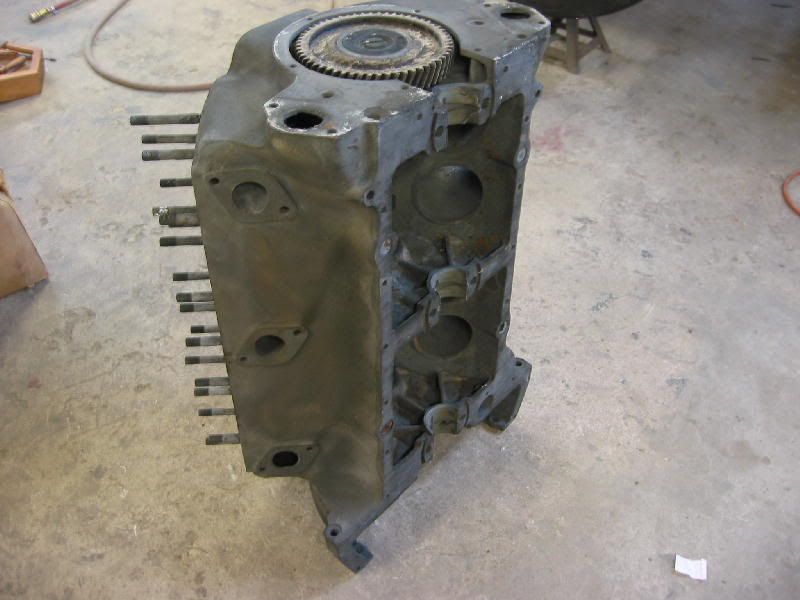 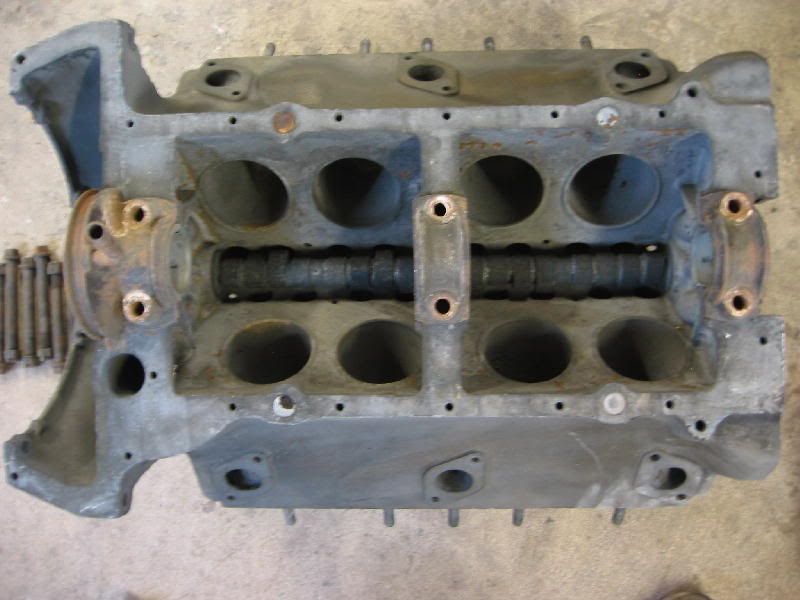 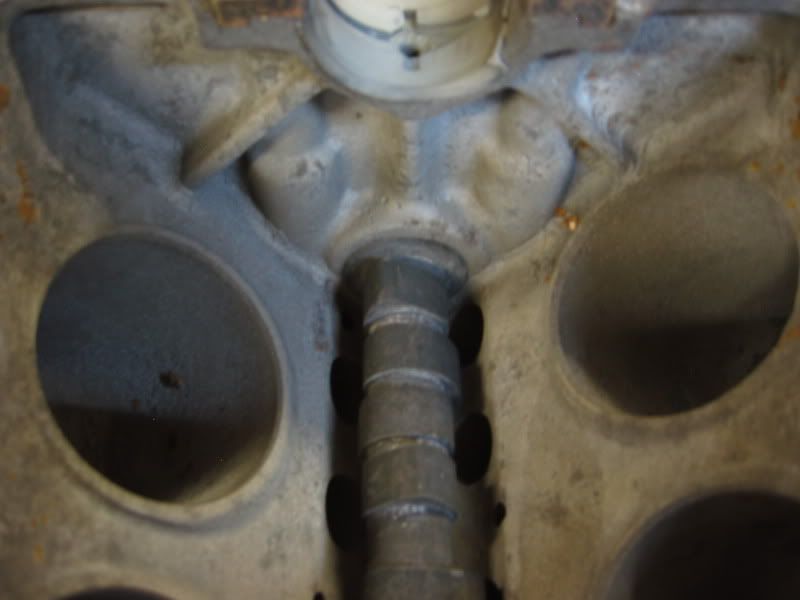 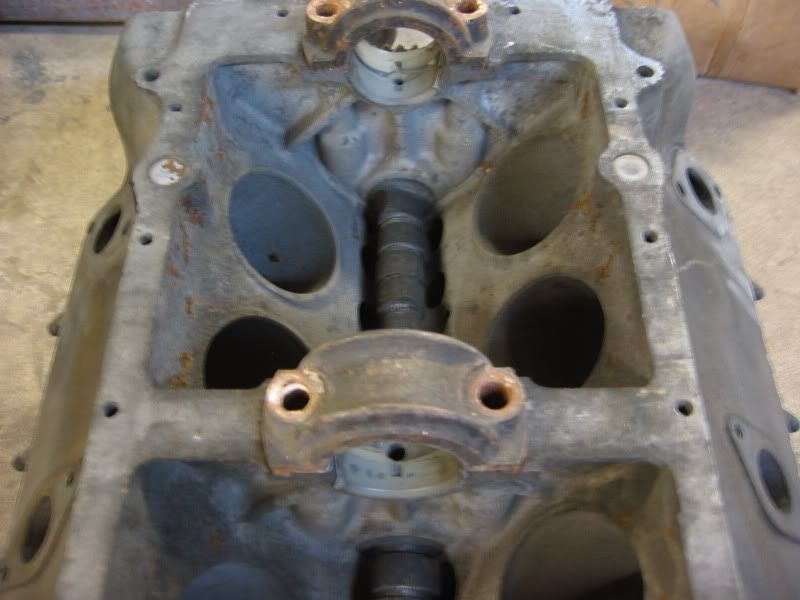 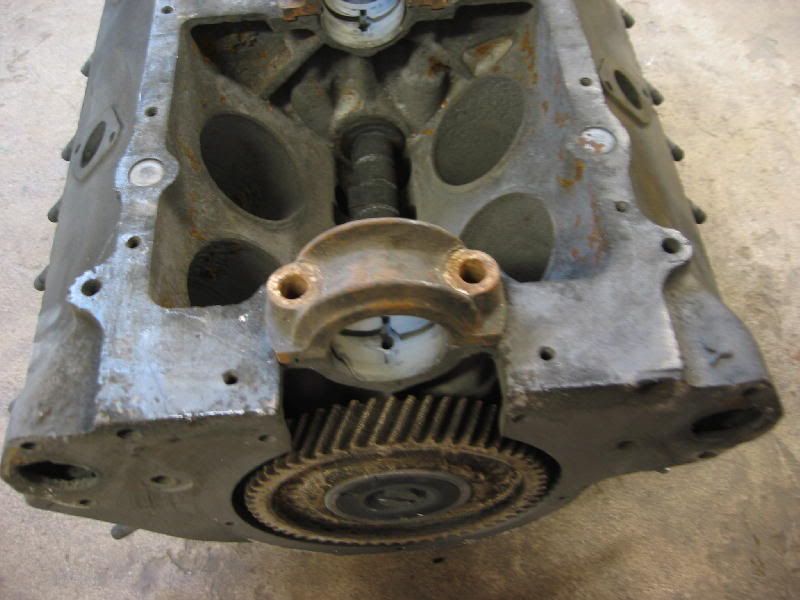   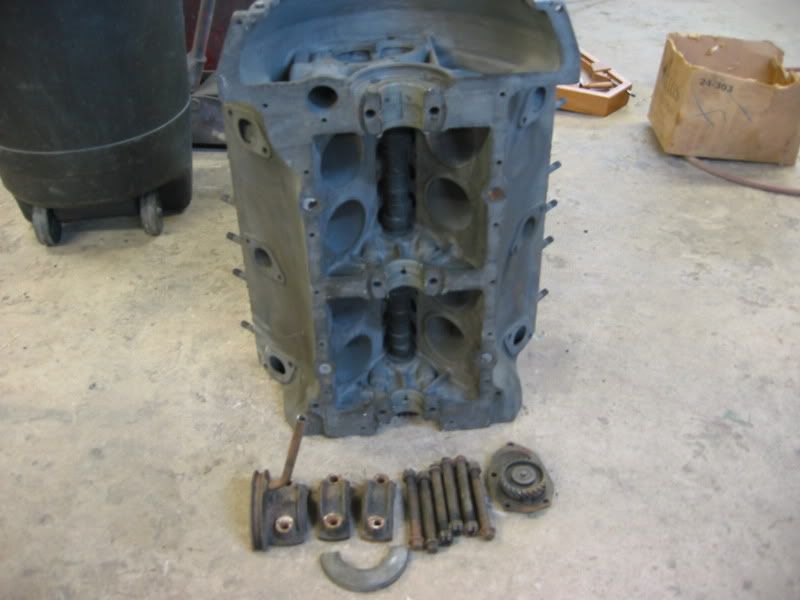 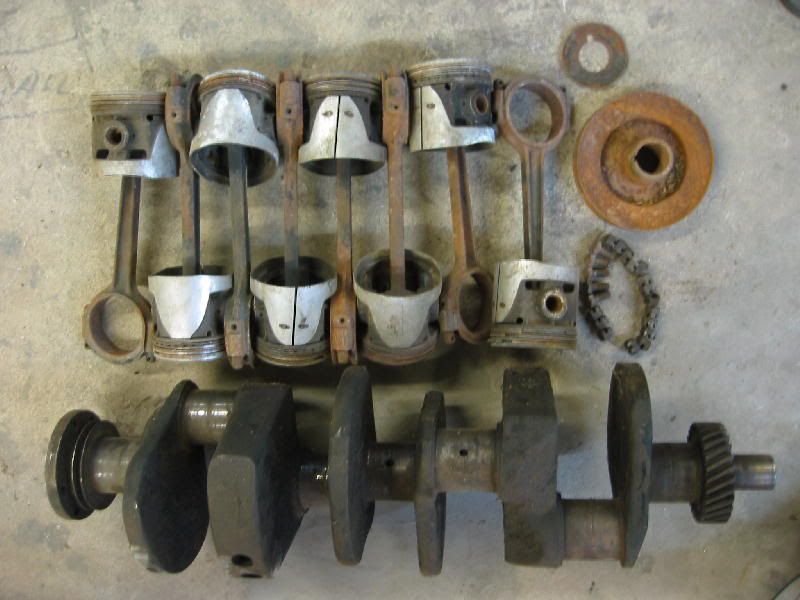
Last edited by Randy; 01-26-2012 at 08:42 PM. |
|
|

|
|
|
#36 |
|
Senior Member
Join Date: May 2010
Location: South Texas
Posts: 1,631
|
Great pictures, Thanks!
|
|
|

|
|
|
#37 |
|
Senior Member
Join Date: May 2010
Location: West Union, Ohio
Posts: 113
|
i Believe the '32-'33 valve guides included a frlange instead of the horseshoe clip. Removal of valves had to be done in the valley as the guides could not come out o the top.
Jim
__________________
Visit my Blown '49 Merc website @ http://www.blown49.com |
|
|

|
|
|
#38 |
|
Senior Member
Join Date: Jun 2010
Location: St Croix Falls WI
Posts: 2,080
|
You are correct sir . Lipped guide is part # 18-6510-A in a December 1932 parts book & the guide with the groove for the horseshoe clip is part # 40-6510 in a March 1934 parts book . Retainer for the big spring is part# 18-6514 & the retainer for the small spring is pt # 40-6514 . Big spring is part # 18-6513 in a December 1932 parts book & part # 40-6513-AR in a March 1934 parts book . Small spring is part # 40-6513-B . The smaller 34-up setup does indeed come out the top & is much easier to deal with . Time & rust-crud sometimes complicate this though . The big spring {32-33} setup is a hassle as like mentioned B4 it only comes out the bottom .
|
|
|

|
|
|
#39 |
|
Senior Member
Join Date: Sep 2010
Location: Merrimac Mass
Posts: 161
|
This is a great post. Thanks for all the information.
|
|
|

|
|
|
#40 |
|
Junior Member
Join Date: Jan 2013
Location: Wisconsin
Posts: 26
|
Ok I think I found it!
|
|
|

|
|
|
#41 |
|
Junior Member
Join Date: Jan 2013
Location: Wisconsin
Posts: 26
|
[ATTACH]h[/ATTACH]
Just got it on the stand. |
|
|

|
|
|
#42 |
|
Senior Member
Join Date: May 2010
Location: Solihull, England.
Posts: 8,747
|
Great post, Thanks for starting it off, 38coupe. Thanks to the other contributors too.
I missed this the first time round. I've been interested if flattys for decades now, and this is the first time I saw or even heard about the lipped guides and big springs. Thanks again. Mart. |
|
|

|
| Sponsored Links (Register now to hide all advertisements) |
|
|
|
|
#43 |
|
Senior Member
Join Date: May 2010
Location: Gardiner Me.
Posts: 4,200
|
I call them core plugs for cleaning sand out of the casting. Walt
|
|
|

|
|
|
#44 |
|
Senior Member
Join Date: May 2010
Location: Chester Vt
Posts: 8,859
|
Yes, this is very educational, I'd like to see the inside of the valve valley more clearly.
|
|
|

|
|
|
#45 |
|
Senior Member
Join Date: May 2010
Location: Kokomo, Indiana
Posts: 1,731
|
Like Mart, I too missed this post the first time around. Very interesting and informative. Many thanks to all who contributed.
__________________
Henry |
|
|

|
|
|
#46 |
|
Senior Member
Join Date: Jun 2010
Location: St Croix Falls WI
Posts: 2,080
|
Sponsored Links (Register now to hide all advertisements)
|
|
|

|
|
|
#47 |
|
Senior Member
Join Date: May 2010
Location: Chester Vt
Posts: 8,859
|
I'd like to see how the main bolts fit into the valley. This is similar ti JWL suggestion for strengthening the crankshaft. Did the front main also come into the valley?? Thanks great pics.
|
|
|

|
|
|
#48 |
|
Senior Member
Join Date: May 2010
Location: Northern California,coast
Posts: 552
|
Thanks 38 coupe,
 great read, like others great read, like others I missed it the first time around, and I will come back and read again..... I missed it the first time around, and I will come back and read again.....  ...OLD....BILL ...OLD....BILL
|
|
|

|
|
|
#49 |
|
Senior Member
Join Date: May 2010
Location: Gardiner Me.
Posts: 4,200
|
Hey Ron, those early blocks 32-3-4 had long main bolts that when down round holes in the valley. the bolts had square heads like a Model A main bearing bolt. You had to have a thin wall square deep socket to go down the hole to hold the head of the bolt. All 3 mains had those bolts. They were a pain in the a--. i'm glade they did away with those in 35. Walt
|
|
|

|
|
|
#50 |
|
Senior Member
Join Date: Jun 2010
Location: St Croix Falls WI
Posts: 2,080
|
Here you are and sorry bout the cobwebs as this thing has been asleep for some time .The holes are sometimes filled with gook and like Walt said they can be a pain to deal with as the square heads don't take a normal socket .
|
|
|

|
|
|
#51 |
|
Junior Member
Join Date: Jan 2013
Location: Wisconsin
Posts: 26
|
Thanks for the pictures. It helps me understand more the correctness of the motor with the car I have. It's all pointing toward being the right block so far, according to the great information on this site. Thanks for the help.
|
|
|

|
|
|
#52 |
|
Senior Member
Join Date: May 2010
Location: Chester Vt
Posts: 8,859
|
Yes, Thank you very much. I like this method of holding in the crank, I wonder why ford changed to studs. Cheaper??
|
|
|

|
|
|
#53 | |
|
Senior Member
Join Date: Jan 2011
Location: Massachusetts
Posts: 465
|
Quote:
|
|
|
|

|
|
|
#54 |
|
Senior Member
Join Date: Jul 2012
Posts: 586
|
Thanks for a great thread-lots of information.
|
|
|

|
|
|
#55 |
|
Senior Member
Join Date: Jun 2010
Location: St Croix Falls WI
Posts: 2,080
|
What you seek is already here . Post 14 has a pic of a one of my 33 motors from the front showing the " recess " . Post 35 has pics of a 32 " non-recessed " block of Randys . If you double click on the 33 pic it will show you a bigger version of the pic . The RH recess on 35-36 blocks is shallower to allow for the vent passage .
|
|
|

|
|
|
#56 |
|
Senior Member
Join Date: Jun 2010
Location: St Croix Falls WI
Posts: 2,080
|
|
|
|

|
|
|
#57 |
|
Senior Member
Join Date: Jul 2010
Location: Conifer, Colorado
Posts: 2,428
|
These are from my 53' Merc. Feel free to use any of these. I have pictures of the finished engine if you want.
|
|
|

|
|
|
#58 |
|
Senior Member
Join Date: May 2010
Posts: 258
|
Randy;
Great 32 block pictures! Good - Good! Good thread 38 Coupe and all posters--still much to learn filling in details on each model. Still looking for 59 "a" (&"AB" if?) USA block, not head, pictures. Canada 59s covered OK , at least to begin--separate Thread? No slight intended. Any others have clear pictures of USA 59 variant "letter" blocks? Upside Y , L blocks have been uploaded. Anyone with X, Z, V, others? Fun and getting better! Gene Tulsa |
|
|

|
|
|
#59 |
|
Senior Member
Join Date: Jul 2010
Location: Conifer, Colorado
Posts: 2,428
|
This will be two postings
|
|
|

|
|
|
#60 |
|
Senior Member
Join Date: Jul 2010
Location: Conifer, Colorado
Posts: 2,428
|
Hope this is what you are looking for...I bought this engine just to learn with.
|
|
|

|
|
|
#61 |
|
Senior Member
Join Date: Jul 2010
Location: Conifer, Colorado
Posts: 2,428
|
This is what it looked like before I cleaned it up
|
|
|

|
|
|
#62 |
|
Senior Member
Join Date: May 2010
Posts: 258
|
Engine builders:
Merc Cruiser has a 59 with N Std piston! What is that -- N series 4 cylinder? Would be 3 3/16 ok. 3 or 4 ring: solid / split skirt? Gene Tulsa |
|
|

|
| Sponsored Links (Register now to hide all advertisements) |
|
|
|
|
#63 |
|
Senior Member
Join Date: May 2010
Location: Gardiner Me.
Posts: 4,200
|
There is probably enough info on this thread BUT, I'm building what I call a rair engine right now. 59 on the bell, won't hold a pencil, has an aluminum rope rear seal retainer in the rear cap, and is 3-1/16 bore. I've had a few of these 59 blocks with 3-1/16 bore but don't remember seeing an aluminum rear cap seal retainer. OH, also has the round boss on top of the bell to drill for full flow filter. It's blocks like this that keeps use old flathead builders on our toes. Walt
|
|
|

|
|
|
#64 |
|
Senior Member
Join Date: Nov 2010
Location: Lancaster PA
Posts: 535
|
What block is this? It appears to be new, the bores are 3.187 with a 3.265 dia x .045 deep counterbore at the top. The mains are 1938 size.
On edit - The mains are .100 larger dia than 1938. Last edited by Yoyodyne; 07-05-2013 at 09:54 AM. |
|
|

|
|
|
#65 |
|
Senior Member
|
Fantastic job 38 Coupe! It must have been painstaking what with all that typing and posting. I'm sure it is appreciated by many beyond words! THANKS
|
|
|

|
|
|
#66 |
|
Senior Member
Join Date: Jun 2010
Location: San Antonio, Texas
Posts: 16,426
|
Sponsored Links (Register now to hide all advertisements)
Last edited by rotorwrench; 07-03-2013 at 08:53 AM. |
|
|

|
|
|
#67 | |
|
Senior Member
Join Date: Nov 2010
Location: Lancaster PA
Posts: 535
|
Quote:
This was under a friends workbench for 20 years, he bought it second hand as a brand new block so it's probably a ford service part. The exhaust ports are perfectly clean and so is the waterjacket, it looks unused to me. There are some miscellaneous numbers and symbols stamped at several locations. |
|
|
|

|
|
|
#68 |
|
Senior Member
Join Date: Jun 2010
Location: San Antonio, Texas
Posts: 16,426
|
Tin can sleeves were common in that time frame. The sleeve could be removed & replaced using standard pistons or they used to have some pistons sized to just hone the bore after removal of the sleeves. Many of these were bored to 3 3/16" and standard 239 pistons fitted. The trapezoidal (keystone shaped) hole in the center of the deck IDs the block as a 221 with 3 1/16" pistons originally. The Mercury & truck 95 HP 239 blocks had round holes in the center of the decks.
If it is already 3.1875 in the bores and can be honed to clean, you can still go with 239 pistons & have a 239 CID motor. |
|
|

|
|
|
#69 |
|
Senior Member
Join Date: Nov 2010
Location: Lancaster PA
Posts: 535
|
Got it, thanks.
|
|
|

|
|
|
#70 |
|
Senior Member
Join Date: May 2010
Location: South Texas
Posts: 1,631
|
Wow, it has been several months since I checked in on this thread. Many thanks to everyone who posted new pictures and added information!
|
|
|

|
|
|
#71 |
|
Senior Member
Join Date: Jan 2011
Location: Christchurch, New Zealand
Posts: 250
|
C69A Engine used in some 48 fords in New Zealand, I have had one with std 59A valve train and one with 8BA valve train. Have an 8BA style rear cap normally although with the one pictured we modified a 59A one as it was missing.
__________________
Life is not a dress rehearsal... |
|
|

|
|
|
#72 |
|
Senior Member
Join Date: Jun 2010
Location: San Antonio, Texas
Posts: 16,426
|
It looks like you have the later type distributor gear on the end of the camshaft. Was it originally set up with an 8BA type distributor or is it converted?
|
|
|

|
|
|
#73 |
|
Senior Member
Join Date: Jan 2011
Location: Christchurch, New Zealand
Posts: 250
|
No I converted the entire front end and all internals, 4"Mercury Crank, rods, valve train to 8BA.
__________________
Life is not a dress rehearsal... |
|
|

|
|
|
#74 |
|
Senior Member
Join Date: May 2010
Posts: 258
|
BTT -- Engine ID w Pictures
|
|
|

|
|
|
#75 |
|
Senior Member
Join Date: May 2010
Location: Garlic Country of CA
Posts: 537
|
I have a couple of prewar 3 3/16 bore blocks with the keystone water passage. One of the blocks has an extra tapped oil hole into the oil passage at the rear of the block. The photo of the 59L block in previous posts show the boss but the hole is untapped. My question is how was the this used in the system? Did it allow for a full flow oil filter or oil cooler connection. I'm adding a "59 type oil filter" and am wondering if I could plumb it with this hole. The 3 tapped holes on the bell housing area are all into the same passage way which is confusing me.
Any ideas? I'll try to post a pic in the next day or 2. Thanks Paul J. |
|
|

|
|
|
#76 |
|
Senior Member
Join Date: Jul 2010
Posts: 2,593
|
If your just gonna run the bypass 59 type oil filter
|
|
|

|
|
|
#77 | |
|
Senior Member
Join Date: May 2010
Location: Solihull, England.
Posts: 8,747
|
Quote:
|
|
|
|

|
|
|
#78 |
|
Senior Member
Join Date: Jun 2010
Location: San Antonio, Texas
Posts: 16,426
|
The original purpose was for an oil cooler installation. The blocks manufactured during and after the war had the boss but not all are drilled and tapped. It depended on the application as to whether it was opened up or not. As was mentioned, the two ports have to be issolated to use for a filter so you have to check for the plug in the horizontal passage between the two.
Bren gun carriers used the early style Canadian block and they had an oil cooler system. These were produced through out the war and many were surplused out after the war. |
|
|

|
|
|
#79 | |
|
Senior Member
Join Date: May 2010
Location: Garlic Country of CA
Posts: 537
|
Quote:
Thanks Paul J. |
|
|
|

|
|
|
#80 |
|
Senior Member
Join Date: May 2010
Location: Solihull, England.
Posts: 8,747
|
A few threads on the subject on the Barn.
https://www.google.co.uk/webhp?sourc...w.fordbarn.com Mart. |
|
|

|
|
|
#81 |
|
Senior Member
Join Date: Aug 2010
Location: Blenheim, New Zealand
Posts: 879
 |
Here's the information on the WWII Canadian lube system used in several applications.
I hope this information is useful to someone out there B) Cheers, Meric.
__________________
I need an 01A 1453 Brkt Spare wheel hold down for my sedan delivery - PLEASE HELP  Gotta love my '42 Sedan Delivery's - Now that I own the only two in New Zealand  http://www.fordbarn.com/forum/album.php?albumid=580 |
|
|

|
|
|
#82 |
|
Senior Member
Join Date: May 2010
Posts: 258
|
Btt
|
|
|

|
| Sponsored Links (Register now to hide all advertisements) |
|
|
|
|
#83 |
|
Member
Join Date: Jul 2010
Posts: 99
|
I picked a 24 studblock thathas59 cast on the bellhousing and has 3 1/6 bore . I haven't giveven it the pencil test yet. What is it and can it be bored out to 3 3/16 ?
|
|
|

|
|
|
#84 |
|
Senior Member
Join Date: Jun 2010
Location: San Antonio, Texas
Posts: 16,426
|
The 41A block was a replacement block for the 221 cid engines starting in late 1944. Production was side by side with the 59 series blocks but they aren't completely the same. The 41A has characteristics of the ealier 221 and the later 239. It may not have very thick cylinder walls but it can be bored to 239 specs without problems unless it has core shift or corrosion.
|
|
|

|
|
|
#85 |
|
Senior Member
Join Date: May 2012
Location: Ashland City, TN
Posts: 130
|
Thanks 38 coupe and all contributors for the wealth of information. Here are a few pictures of what we believe to be a 38 221 Canadian block 24 stud 3.06 bore. It has 81 cast in front of right bank, flat intake surface, drilled and tapped 3 oil ports at rear and one below dipstick tube, dimples in pan rail, with long crank snout. It also has a sleeve in the fuel pump rod bore.
Last edited by gmanrides; 01-13-2015 at 12:13 AM. |
|
|

|
|
|
#86 |
|
Senior Member
Join Date: Jul 2012
Location: France
Posts: 111
|
Sponsored Links (Register now to hide all advertisements)
Someone take off some parts like the starter, the carb, the ignition, the tranny, the rear axle and the seat before I bought the car. |
|
|

|
|
|
#87 |
|
Senior Member
Join Date: May 2010
Location: southeastern Michigan
Posts: 10,101
|
The fuel pumps went through lots of changes in the early V8 years so a later fuel is an indicator of nothing more that it is a later fuel pump. Whether or not your engine was manufactured during the 1932 model year is determined by the engine block itself and not by the vintage of the attached parts attached to the block. The two defining characteristics of a '32 block are the location of the water drain cocks and the extent of the front machined surface of the block. Both of these characteristics are shown in photos earlier in this thread.
|
|
|

|
|
|
#88 |
|
Senior Member
Join Date: Jul 2012
Location: France
Posts: 111
|
It's a '32 : drain valves are straight and the front of the engine is flat.
Thank you DavidG. And if anyone has the parts I need ... |
|
|

|
|
|
#89 |
|
Senior Member
Join Date: Jun 2010
Location: St Croix Falls WI
Posts: 2,080
|
Bringing this back as it answers current questions
|
|
|

|
|
|
#90 |
|
Senior Member
Join Date: May 2010
Location: southeastern Michigan
Posts: 10,101
|
Here's a photo of the front of a very early '32 V-8. The boss immediately above the timing gear cover (which itself is unique as it lacks the ribs of the later covers) relates back to the first version of the timing gear cover (and distributor) which were recalled in a service campaign shortly after '32 model public introduction day.
|
|
|

|
|
|
#91 | |
|
Senior Member
Join Date: Jan 2011
Location: Central Ohio
Posts: 5,064
|
Quote:
|
|
|
|

|
|
|
#92 |
|
Senior Member
Join Date: May 2010
Location: southeastern Michigan
Posts: 10,101
|
As requested, the photos below are of the first '32 timing gear cover and the matching distributor. Several of the recalled distributors have survived the normal Ford practice of destroying such parts, but the timing gear cover shown may well be one of only two escapees.
|
|
|

|
|
|
#93 |
|
Senior Member
Join Date: Jun 2010
Location: Redwood City, CA
Posts: 1,591
|
Great post thank you all for sharing photos and historic time frame evolution of the V8....
__________________
1928 "A" Phaeton (mid year with many early features) 1933 "V8" Closed-Cab Pickup Truck (originally a Model B, 4 Cylinder dating to May, 1933)
|
|
|

|
|
|
#94 |
|
Senior Member
Join Date: May 2010
Location: (Not far enough...) Outside of DC
Posts: 3,387
|
More please?!? Anything you think we need to know.
__________________
-Jeff H Have you thought about supporting the Early Ford V-8 Foundation Museum? |
|
|

|
|
|
#95 |
|
Member
Join Date: Jul 2014
Location: Tempe AZ
Posts: 54
|
Rather than start a new thread, I figured this would be a better place.
Recently got this block and trying to ID it. From everything I can find it appears to be a 239 from a 39-41 (closer to 41?) truck based on the stamp on the left rear of the block 99T-638628 and the lower water passage. From what I can gather this is a good block but one question is whether parts for a "59" block will fit properly.  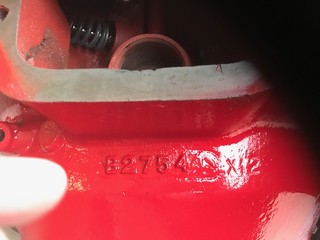 |
|
|

|
|
|
#96 |
|
Senior Member
Join Date: May 2010
Location: upstate new york
Posts: 758
|
Are 32 heads very rare?
|
|
|

|
|
|
#97 |
|
Senior Member
Join Date: May 2010
Location: southeastern Michigan
Posts: 10,101
|
Not particularly (about $100+ a pair for the two most common varieties). There were three versions depending on when they were produced during the '32 model year. The first version had cast-in part numbers followed by either RH or LH (as though that was not obvious from where the water pumps attached). The second version excluded the RH and LH and occurred early in the model year. The third version had no part numbers and was adopted about mid year.
The first version might command a price premium as it is the rarest of the three, although it's appeal is likely to be limited to those with early engines (all of whose components are rare and expensive). |
|
|

|
|
|
#98 |
|
Senior Member
Join Date: Jun 2010
Location: San Antonio, Texas
Posts: 16,426
|
[QUOTE=AZ Chris;1388171]Rather than start a new thread, I figured this would be a better place.
Recently got this block and trying to ID it. From everything I can find it appears to be a 239 from a 39-41 (closer to 41?) truck based on the stamp on the left rear of the block 99T-638628 and the lower water passage. From what I can gather this is a good block but one question is whether parts for a "59" block will fit properly. If it has bulges on each side of the pan rail with core plugs then it is early 39/40 type. If it has no core plugs on the pan rail and has a raised appearance on the intake deck then it would be 41/42 type. If it has the 29A con rods then it is a direct interchange for rotating assemblies with the 59 series. The 59 stuff will fit it though as long as you use all the right parts. The only real difference then would be that it has thicker cylinder walls and the earlier type valve angles. |
|
|

|
|
|
#99 | |
|
Member
Join Date: Jul 2014
Location: Tempe AZ
Posts: 54
|
Quote:
|
|
|
|

|
|
|
#100 |
|
Senior Member
Join Date: Jun 2010
Location: San Antonio, Texas
Posts: 16,426
|
The valve angle will depend on the heads you use. If you have and older 99, 09, 19, or 29 type block (1939 through 42 239-CID), you can either use the old original 99T, 81A (big A heads), or other early type pre-war heads that are non-59 series with no problems. If you use later 59 series heads or some of the aftermarket heads, you might have to do a little bit of relief in the valve areas of the chambers to make sure they don't make any contact in there. You can convert everything to 8BA style too if you want to use a 4-inch Mercury type crankshaft.
They used to make tools to do the valve relief work but they are getting hard to find. A little work with a die grinder might do the trick too as long as you go at it in a scientific manner. |
|
|

|
|
|
#101 |
|
Senior Member
Join Date: May 2010
Location: Oshkosh, Wi
Posts: 4,526
|
The round water hole in the center denotes it as a Mercury block - 3 3/16 bore x 3 3/4 stoke.
|
|
|

|
|
|
#102 |
|
Senior Member
Join Date: Jan 2011
Location: Central Ohio
Posts: 5,064
|
Quote:
I have my own sonic tester and have tested a lot of different blocks - can find no consistent correlation between block year/type/nomenclature and being thicker than others. As some noted, it should have the earlier valve angles (32-42) - but they are only slightly different from the 46-53 engines. There is some debate whether or not the 39-42 Mercuries used the LATE valve angle or the early one - I've never been able to confirm this. (To move the valves further away from the bigger 3 3/16 bore). Valve angle: 32-42 = 101.45 degrees, 46-53 = 100.026 degrees It is always wise to check for valve to head clearances - especially if you're running the early (small chamber) heads and/or an unknown cam. You can do this with a gasket and some modeling clay - you'll want .060+ minimum over the valves at the top of the pockets in the heads (which is where they would hit if they are too close). |
|
|

|
| Sponsored Links (Register now to hide all advertisements) |
|
|
|
|
#103 |
|
Senior Member
Join Date: Jun 2010
Location: San Antonio, Texas
Posts: 16,426
|
I haven't worked on any 41/42 Merc/truck blocks or wartime ones either but the 99 block that I have seen (1939) does have thicker walls. Maby not a lot thicker but noticably thicker through the water jacket ports than a 59 series. FoMoCo was changing the castings in the 41/42 time frame plus the wartime stuff may have been affected by shortages of materials. The most common wartime vehicles I've seen that had US built V8 engines were big COE transport trucks. I don't know how many were made for the war effort but I've seen pictures of them in Red Ball Express photos and others. These trucks were easy to maintain and the engines could be changed quickly if the maintenance facility had the cradle tools. Ford made a lot of G8T trucks but they were all 6-cylinder. Ford made other conventional cab big trucks for fire engines and they made the bomb loaders but I don't know if they had V8 engines or not. The bomb loaders resemble the CMP trucks made in Canada. My Pops outfit in Foggia, Italy had both the fire trucks and the bomb loaders. I just wish he were still around to answer questions about them. I'm sure all that stuff stayed in Europe & North Africa after the war.
|
|
|

|
|
|
#104 |
|
Member
Join Date: Jul 2014
Location: Tempe AZ
Posts: 54
|
Thanks everyone. Much appreciate all the information!
|
|
|

|
|
|
#105 |
|
Senior Member
Join Date: May 2010
Posts: 258
|
Btt
|
|
|

|
|
|
#106 |
|
Senior Member
Join Date: May 2010
Location: Northern Neck, VA
Posts: 131
|
Sponsored Links (Register now to hide all advertisements)
|
|
|

|
|
|
#107 |
|
Senior Member
Join Date: Apr 2013
Location: Big pine Ca 93513
Posts: 797
|
Thanks for posting ..very good info ..sc
|
|
|

|
|
|
#108 |
|
Senior Member
Join Date: May 2010
Location: Lexington, NC
Posts: 860
|
I wrote that article years (decades) ago long, before digital cameras. If I recall, the pictures were in black and white....anyone remember them?
|
|
|

|
|
|
#109 |
|
Senior Member
Join Date: May 2010
Posts: 258
|
Bsck to Top
See 36 LB ID --post # 14 |
|
|

|
|
|
#110 |
|
Senior Member
Join Date: Jun 2010
Location: St Croix Falls WI
Posts: 2,080
|
BTT Some questions currently this should help with .
|
|
|

|
|
|
#111 |
|
Senior Member
Join Date: May 2010
Location: South Texas
Posts: 1,631
|
Well it has been a decade since I started this thread. Lots of good information and help was added during that decade. However, I hosted the pictures for the original postings of this thread on photobucket, and they changed their minds on how they operate (I never paid them money so I can't complain).
Since the early pictures are at best now only thumbnails, I have a question: Should I attempt to update the original posts? Should I attempt to duplicate the original posts here at the bottom of this old thread with attached pictures instead of linked pics? Should I start a new thread instead of making new members scroll down through all of this one (I'm really conflicted on that idea since so many people contributed to this thread)? At the minimum I can offer a chart with USA production line V8 engine identification as a sort of quick reference (see attached pdf). Edit: I checked. I cannot edit any of my older posts in this thread. Last edited by 38 coupe; 04-10-2021 at 08:07 AM. Reason: Note about limit on editing old posts |
|
|

|
|
|
#112 |
|
Senior Member
Join Date: Jul 2011
Location: SF Bay Area
Posts: 6,641
|
I for one very much appreciate your research and have learned from your work. I'm sure many others have also. As Photobucket is no longer viable for this thread, whatever method you decide on that can refresh the info presented is above and beyond! Thank you!
__________________
Alan |
|
|

|
|
|
#113 |
|
Senior Member
Join Date: May 2010
Location: Northern Neck, VA
Posts: 131
|
@38coupe Thank you for posting the chart. It would be great to have the earlier pictures posted again, it would keep this thread as the "go to" place for block identification.
|
|
|

|
|
|
#114 | |
|
Member
Join Date: Jun 2015
Location: Finland
Posts: 76
|
Quote:
I think update original pics would be best? This is great thread, thanks! Deserves to be at top, sticky? is that possible here? |
|
|
|

|
|
|
#115 |
|
Senior Member
Join Date: Jun 2010
Location: San Antonio, Texas
Posts: 16,426
|
I don't know if you can update the older posts. You might try it to see if it will work. If not, a person would have to repost these items with new entries.
This has been a problem with a lot of the older threads that predate the change from using links to photo sharing sites to posting directly to the threads. |
|
|

|
|
|
#116 |
|
Member Emeritus
Join Date: Nov 2012
Location: Wichita KS
Posts: 16,132
|
I agree, you might not be able to update older post. If you can, might just add a note that the photos are added to the end of the thread.
Last edited by JSeery; 04-05-2021 at 02:49 PM. |
|
|

|
|
|
#117 |
|
Senior Member
Join Date: May 2010
Location: papillion nebraska
Posts: 406
|
I have a relieved 59 block which has no 'L' designation immediately after the '59' but rather slightly off to the left top side of the bell housing near the 1/8"npt tapped oil gallery & the 'L' is read while facing the block from the right side. Just curious if it is a bonified 'L' code block ? anyone able to i.d. ? it has what looks to be factory intact paint but a much brighter green than I'm familiar with.
|
|
|

|
|
|
#118 |
|
Senior Member
Join Date: May 2010
Location: South Texas
Posts: 1,631
|
Allmost 59 marked blocks are equivalent. The exception is the over the counter replacement blocks cast with the smaller 221 motor size bore of 3 1/16 inches. All the speculation about different letter blocks being better has turned out to be just speculation. No metallurgical difference and no cylinder wall thickness has been found.
|
|
|

|
|
|
#119 |
|
Senior Member
Join Date: May 2010
Location: South Texas
Posts: 1,631
|
After thinking about it I decided to post pictures here at the bottom of this thread, and edit the old posts to reference the attached pictures. I'm planning on a post per engine group (1932 post, 33-34 post, etc).
Here is the post with 1932 engine block pictures. Many of the pictures were gathered from this thread, many thanks. |
|
|

|
|
|
#120 |
|
Senior Member
Join Date: May 2010
Location: South Texas
Posts: 1,631
|
Here is the post with 33-34 engine block pictures. Again, many of these pictures were provided by gracious and helpful people earlier in this thread.
|
|
|

|
|
|
#121 |
|
Senior Member
Join Date: May 2010
Location: South Texas
Posts: 1,631
|
Here are the 35-36 pictures. Again, with thanks to others on this thread.
|
|
|

|
|
|
#122 |
|
Senior Member
Join Date: May 2010
Location: South Texas
Posts: 1,631
|
Here are the LB pictures. I realize I don't have a picture of the main bearing stud spacing (looks about 3 1/4 when measuring center to center with your tape measure or scale), which is my go-to way of IDing an LB. This deficiency is particularly egregious since I could have done so last month at the Chickashaw swap meet. My apologies.
In the picture with the two oil pans the left pan is from an LB and the right pan is from a Babbitt motor. |
|
|

|
| Sponsored Links (Register now to hide all advertisements) |
|
|
|
|
#123 |
|
Senior Member
Join Date: May 2010
Location: South Texas
Posts: 1,631
|
Here are the 37-38 late 21 stud pictures.
|
|
|

|
|
|
#124 |
|
Senior Member
Join Date: May 2010
Location: South Texas
Posts: 1,631
|
Here is the 1938 only 24 stud picture (note short crank, 24 studs, and pencil test):
|
|
|

|
|
|
#125 |
|
Senior Member
Join Date: May 2010
Location: South Texas
Posts: 1,631
|
Here are the 39-40 Ford (221 cubic inches) pictures:
|
|
|

|
|
|
#126 |
|
Senior Member
Join Date: May 2010
Location: South Texas
Posts: 1,631
|
Sponsored Links (Register now to hide all advertisements)
|
|
|

|
|
|
#127 |
|
Senior Member
Join Date: May 2010
Location: South Texas
Posts: 1,631
|
Here are the 41-42 Ford (221 cubic inches) pictures:
I don't have a picture yet! Working on it... |
|
|

|
|
|
#128 | |
|
Senior Member
Join Date: May 2010
Posts: 195
|
Quote:
|
|
|
|

|
|
|
#129 |
|
Senior Member
Join Date: May 2010
Posts: 195
|
Core clean out plugs
|
|
|

|
|
|
#130 |
|
Senior Member
Join Date: May 2010
Location: South Texas
Posts: 1,631
|
Here are pictures of 41-42 Mercury (239 cubic inch) blocks:
|
|
|

|
|
|
#131 |
|
Senior Member
Join Date: May 2010
Location: South Texas
Posts: 1,631
|
I don't have pictures of World War 2 era blocks. Instead I'll post pictures of two blocks damaged by hanging them only from the thin cast on bell housing from modern engine stands. I'm not saying this will happen to your engine if you do this, but it might.
|
|
|

|
|
|
#132 |
|
Senior Member
Join Date: May 2010
Location: South Texas
Posts: 1,631
|
Here are pictures of "59 series" 46-48 engines:
|
|
|

|
|
|
#133 |
|
Senior Member
Join Date: May 2010
Location: South Texas
Posts: 1,631
|
Here are pictures of 49-53 8BA blocks:
|
|
|

|
|
|
#134 |
|
Senior Member
Join Date: May 2010
Location: Powell, TN
Posts: 2,509
|
Cannot get any of the pics to enlarge, when clicked on, this msg comes up:
<Error> <Code>AccessDenied</Code> <Message>Access Denied</Message> <RequestId>33KWSJ9Z8RTVGNJE</RequestId> <HostId>EoZtdOwJKaR9UxBoeFMQYGY2l7X/ZHNCeHEF56kTgPMRkahg8oLki7f0yItrjlEmpvvt0q/B19A=</HostId> </Error> |
|
|

|
|
|
#135 |
|
Senior Member
Join Date: May 2010
Location: Powell, TN
Posts: 2,509
|
Opps, see further down 28 cpe corrected the problem with new pics.
|
|
|

|
 |
«
Previous Thread
|
Next Thread
»
|
|
| Sponsored Links (Register now to hide all advertisements) |
|
|
All times are GMT -5. The time now is 03:49 AM.
































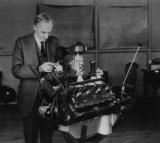













 Linear Mode
Linear Mode

